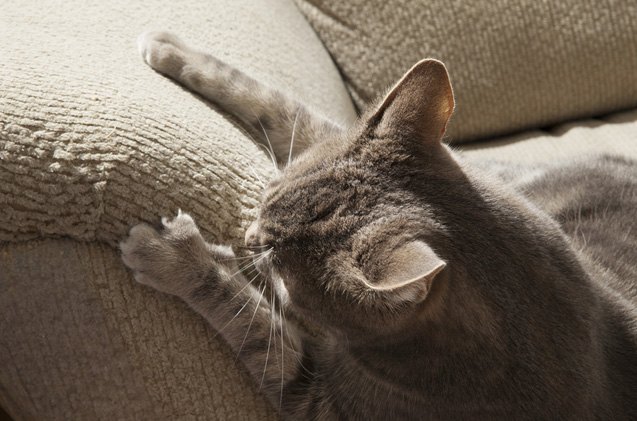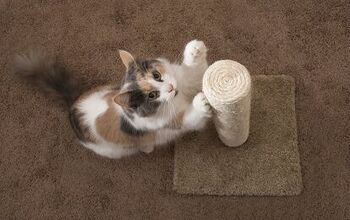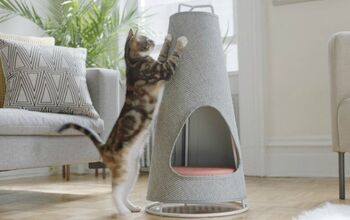Tips on How to Pick Furniture Your Cat Won’t Scratch

The only thing worse than a couch covered in cat hair is a couch covered in scratch marks. Scratching is a natural behavior for cats and it is something they have a physical need to do, but that doesn’t mean you have to let them do it on your furniture.
One thing to keep in mind is that your cat might be tempted to scratch your furniture based on how it feels, so there are steps you can take to ensure you buy furniture that won’t tempt your kitty into using it as a scratching post. It might even take a bit of trial and error to figure out what your cat won’t scratch–every cat is a unique individual, after all. But once you get the hang of things, you will be able to have fabulous furniture in a home with one or more cats, so everyone can be happy, including your furkids.
In addition to providing your cat with a scratching post, choose carefully when furniture shopping to reduce the risk of having your new furniture scratched to pieces. Below are some recommendations and tips that you can put to use right away.
Not only is scratching a normal part of cat behavior, but it actually serves several important functions. For one thing, scratching helps to condition the claws by removing worn and frayed outer claws, making room for new growth. Your cat also has scent glands between his toes that produce an odor that is unique to him – by scratching things with his claws he is spreading that scent and effectively marking his territory. Scratching also simply feels good for cats because it helps them to stretch out their bodies while also flexing their feet and claws.
For all of these reasons, and more, there is no reason to stop your cat from scratching. Instead, as a cat owner, you need to accept that this is totally normal and necessary feline behavior. But, again, this does not mean that you have to sacrifice your beautiful and comfortable furniture to have a happy kitty in your home.
Related: Works of Art You Want Your Cat to Shred
If your cat has a tendency to scratch your furniture, don’t turn to declawing as the solution. Declawing a cat isn’t a harmless procedure similar to trimming your fingernails. In reality, the surgical procedure used for declawing actually removes the last bone on each of the cat’s toes, not just the claw.
This procedure can lead to lasting physical problems for cats and it may also contribute to problem behaviors like aggression and failure to use the litter box. It is no surprise, then, that so many animal advocates, experts, and vets have been speaking out against declawing cats. And many pet owners are choosing to avoid this procedure. Not only is it cruel, it’s also unnecessary because there are many different solutions and strategies that you can implement if your cat is scratching your furniture.
Related: Declawing Cats: A Cruel and Unnecessary Procedure
Before we dive into the types of furniture that can work well in homes with frisky felines, let’s cover a basic step you can take to help prevent your kitty from damaging your furniture and other belongings: keep his claws trimmed.
There are scissors specifically designed for trimming a cat’s claws, so purchase a pair and keep them on hand. Then, simply trim your pet’s claws at home on a regular basis. Not only will this help prevent damage to your furniture, but it can also help you avoid getting scratched up by accident when playing with or holding your cat.
Training your cat to tolerate having his claws trimmed might be more challenging when she’s older, so starting young is a great idea. But don’t lose hope even if your kitty is an adult and isn’t used to this. Just take your time and ask an expert, such as your vet, for help if you need it.
The best way to ensure that your cat doesn’t scratch your furniture is to provide him with plenty of alternative options that blend in with the surroundings. If you’re worried about matching your trending decor, spend a little extra on a deluxe or modular style – there are plenty available, online or in store. A rope-covered scratching post or a scratch pad made from cardboard are great options that your cat will like to scratch – you can rub them with catnip to make them more appealing to your cat.
Another option would be to implement strategies for deterring your cat from going on your furniture or using it as a scratcher. Sometimes, covering an area with sandpaper, foil, or double-sided tape will make it unappealing to your cat. And you can try spraying your furniture with citrus or menthol – two scents that cats can’t stand. But if you are going to use any products with fragrances, even if they consist of essential oils, just be sure that they will be safe for your pets.
If you are going to buy new furniture, you should also be mindful about the style and the materials you choose because this will affect how likely your cat is to find the furniture appealing for scratching.
The best material to choose in a house with cats is microfiber. Microfiber is a smooth, soft fabric and those qualities are the opposite of what cats like in terms of texture. Cats like to scratch things that will help wear down their nails and this won’t happen with microfiber – microfiber also doesn’t tend to snag or run like other upholstery materials. For the most part, microfiber simply doesn’t collect signs of scratching like claw marks, holes, pulls, or tears. It also doesn’t hurt that microfiber is easy to clean and it doesn’t tend to collect dust and dander like other materials.
Replacing your existing furniture with microfiber may be the most effective solution to cat-scratched furniture, though don’t forget to provide your cat with a scratching post or two as well.
Whatever you do, do not try to discourage your cat from scratching by punishing him. For one thing, he will not understand why he is being punished and he might start forming a negative association with you. It is also possible that you could hurt your cat by accident. Most problem behaviors can be solved simply by providing your cat with an alternative means for expressing the undesired behavior – a method that does not have a negative effect on you, your furniture, or your home.
By understanding your cat’s natural behaviors and needs, you can begin to take the right approach when it comes to giving him the perfect home. Keep the tips above in mind as you enrich his environment and design your space to suit both of you.

Kate Barrington is the loving owner of two cats (Bagel and Munchkin) and a noisy herd of guinea pigs. Having grown up with golden retrievers, Kate has a great deal of experience with dogs but labels herself a lover of all pets. Having received a Bachelor's degree in English, Kate has combined her love for pets and her passion for writing to create her own freelance writing business, specializing in the pet niche.
More by Kate Barrington























